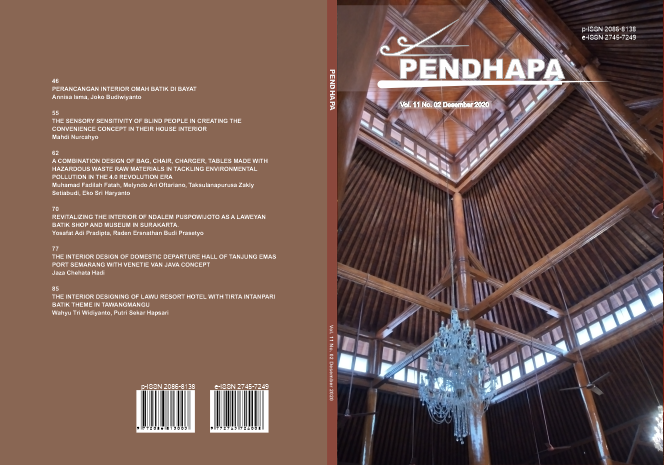The Interior Designing of Omah Batik in Bayat
DOI:
https://doi.org/10.33153/pendhapa.v11i2.3278Keywords:
Interior Oma Batik, Motif batik, Art decoAbstract
The interior Designing of Omah Batik in Bayat is aimed at accommodating the activities of developing traditional batik, especially in Bayat by presenting the theme of several motifs on batik which are packaged in art deco style. This design offers facilities such as galleries, shops, vehicle repair shops, cafes, and lobbies. This goal is achieved by a design method that uses a design process including input, synthesis, and output. The input is in the form of literature, field data, and synthesis through the design analysis process; whereas the output is in the design results. The approach used is the approach to function, ergonomics, themes, and styles as well as materials. The design analysis takes ideas from several batik motifs, such as kawung, sidomukti, and parang motifs combined with art deco patterns. The design result is the interior design of Omah Batik in Bayat which has several main facilities such as a lobby, shop, gallery, café, and vehicle repair shop. Supporting facilities include inns, audio-visual rooms, and a library in art deco style.
Downloads
References
Joko, Budiwiyanto. Penerapan Unsur – Unsur Arsitektur Tradisional Jawa Pada Interior Public Space Di Surakarta, Surakarta.
Djumeda,Nian.S.1986. Ungkapan Sehelai Batik Its Mystery and Meaning. Jakarta : Djambatan.
Karlen,Mark. Dasar- Dasar Perencanaan. Jakarta: Erlangga.
Samsi,Sri Soedewi.2007. Motif,Proses,dan Tekhnik Pembatikan”Makalah disampaikan dalam Seminar Batik Nasional di Pendapa Balai Kota Surakarta
R. Ismunandar K. 1986 . Joglo . Semarang: Dahara Prize.
Tim Penyusun. 2001. Kamus Besar Bahasa Indonesia. Jakarta: Balai Pustaka.
etd.repository.ugm.ac.id/downloadfile/91262/.../S1-2015-313253-introduction.pdf
www.kelasdesain.com(diakses 06september2018,pukul19:55 WIB)
www. Google image.com (Diakses pada febuari 2018,pukul 13:00WIB)
www. Info batik.id
Downloads
Published
Issue
Section
License
Authors who publish with Pendhapa agree to the following terms:
- Authors retain copyright and grant the journal right of first publication with the work simultaneously licensed under a Creative Commons Attribution License (CC BY-SA 4.0) that allows others to share the work with an acknowledgment of the work's authorship and initial publication in this journal.
- Authors are able to enter into separate, additional contractual arrangements for the non-exclusive distribution of the journal's published version of the work (e.g., post it to an institutional repository or publish it in a book), with an acknowledgment of its initial publication in this journal.
- Authors are permitted and encouraged to post their work online (e.g., in institutional repositories or on their website) prior to and during the submission process, as it can lead to productive exchanges, as well as earlier and greater citation of published work.

This work is licensed under a Creative Commons Attribution-ShareAlike 4.0 International License.









